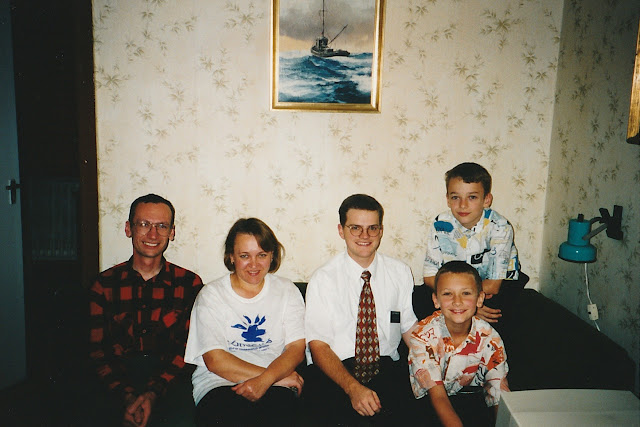16 years ago I served in a small city in the eastern part of Hungary called Nyíregyháza. Nyíregyháza translated into English means "birch church". I was there for eight months and I have been fortunate enough to have kept in contact with a few people I met there. So, when we visited Hungary we planned a day trip to visit them in Nyíregyháza. It was truly a highlight to meet with and interact with people we had some connection with while there.
Here is the main square on Nyíregyháza 16 years ago. My companion and I are here on a P-Day. That's Elder Grover, who was with me for a few months.
This time I have my favorite travelling buddy with me, Craig!
Nyíregyháza is a town of about 100,000 or so people. It's the smallest town I served in as a missionary. It's a really nice town with a very clean city center and lots of statues...
... including one of Kossuth Lájos. Remember him from my last post? In addition to being in Washington D.C., he's found in almost every Hungarian town.
Here is a picture of the Nyíregyháza Branch all those years ago. This isn't everyone, but it's most of them. We were a small branch, but many of those pictured here are still faithful in the Church. I'm going to make a more particular mention of two families, although there are lots of stories from the people in this picture. I am in this picture, and if you're sharp, you'll find me somewhere in the middle. This was the last day I was in Nyíregyháza back in October of 1999. To the right of me (my left in the picture) is Vékony Sándor, and at the far right of that row is Kovács Ferenc with the gray hair and glasses. Back then, we rented out a building on Sundays to have church meetings in.
This is a few months earlier, when Vékony Sándor and his mom, Jelena, and brother, Viktor were baptized. Sándor is the boy on the left and Viktor is on the right. Yup, I'm in this one too, without my glasses. In those days we rented out a swimming pool for baptisms. The swimming pool is Olympic-sized, and Olympic deep! Poor Viktor and Sándor couldn't touch the bottom of the pool. So, being the enterprising 20-year-olds that we were, we grabbed plastic chairs and sank them in the pool so that Viktor and Sándor could stand on them during their baptism. So Viktor and I went into the pool together, and the chair idea seemed to work very well, until after the actual immersion, when Viktor was kicking and hanging on to me because the chair had floated away while he was under the water!
Here we all are on dry land with the Vékony family in their apartment. Jelena and Viktor still live in Nyíregyháza. Sándor works in another city near Budapest, but visits on the weekend. Sadly, their father passed away from cancer a few years ago. Viktor, the smiling little boy in the front, reached out to me a few years ago on Facebook. Viktor is now a dance instructor, and teaches ballroom dance in Romania. He also served his mission in Romania, and is currently serving as the Branch President in Nyíregyháza!
And here is the Vékony family now! I didn't recognize Sándor at first - I can't believe he's taller than I am! Jelene is still the same, always smiling and happy. And Viktor is also taller than I am. The cute blondie in the middle is my little boy Craig, now 10 years old! The Vékony family treated us to some wonderful Ukrainian lunch that we all enjoyed!!
The Vékony family weren't the only ones to invite us over. Kovács Ferenc and his lovely wife also had us come! They made the quintessential Hungarian dish for us: Paprikás Csirke. I think we all had at least 3 helpings!! While we were there, Ferenc reminded me of a few things that I had forgotten about. Ferenc was found by the Sister missionaries and was baptized just a month or so before I came to Nyíregyháza. I was assigned as his first home teaching companion, and later ordained him to the Melchizedek Priesthood. After I left, Ferenc was called as a councilor, and then as the Branch President. He is currently serving as a councilor in the District Presidency. He reminds me of a Stake President - a priesthood man through and through! I could not have imagined that Heavenly Father had such a work for this man to do!
And the little Nyíregyháza Branch also has a place of their own! They have a long-term lease on the second floor of this building. They have almost outgrown it, and are working hard to have a permanent church built nearby! They are still small but mighty, with plenty of new faces and a few familiar ones.
As this clock in Nyíregyháza can attest to, time sure flies! I can't believe I waited this long to visit, and I will be sure not to wait that long again! Isten veled míg újra látlak!




























